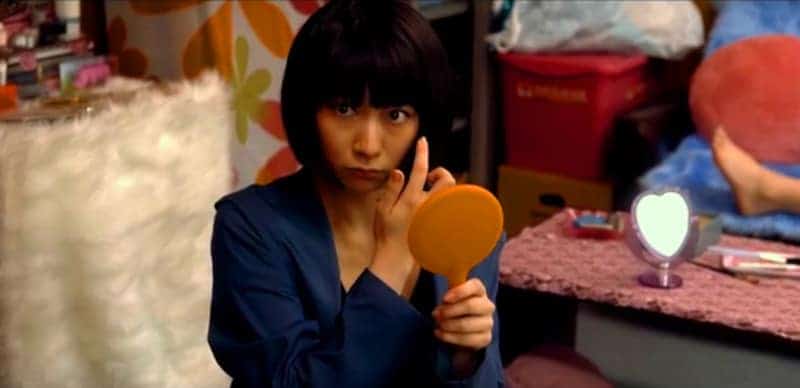“Dawn of the Felines” is one of the five films in Nikkatsu's recent ‘Roman Porno Reboot': a project that was undertaken to celebrate 45 years of the original cycle (1971-1988). Conforming to the strict dictates of the original cycle, “Dawn of the Felines”has a running time of just over 80 minutes (84 minutes), contains a sex scene at least every 10 minutes, and was shot in just a week. It is the third film in the series and was released on 14th January 2017 in Japan. It can also be considered a sequel or homage to Night of the Felines (Tanaka Noboru: 1972) which deals with the lives of three sex workers who work in a bathhouse brothel.
“Dawn of the Felines” screened at the New York Asian Film Festival 2017
As in “Night of the Felines”, “Dawn of the Felines” focuses in on the daily lives of sex workers, detailing their interactions with their clients in uncompromising but never salacious detail. In contemporary Japan, internet technologies have changed the shape and scope of prostitution. Instead of a bathhouse, the women work as escorts at ‘Young Wives Paradise', a franchise of a bigger organization somewhat inappropriately translated as Health Express. The woman are Yui (Satsuki Maue) a single mother with a young son (Kenta), Misako (Juri Ihata), a college graduate who has find herself homeless due to debt, and Rei (Michie), a wife whose infertility has led to depression. Their clients range from an elderly man, Kaneda (Ken Yoshizawa), who has recently lost his wife, a thirty-something hikikomori, Takada (Tomohiro Kaku), a deeply unlikeable comedian Taniguchi (Hideaki Murata) and the sleazy owner of the escort agency, Nonaka (Takuma Otoo).
While the original cycle of roman porno films were marketed as romantic pornography, there is an absence of romance in “Dawn of the Felines”. The sexual encounters are marked by a mixture of despair and self-loathing on behalf of both parties. The sex is there because it is part of the day to day life of the women – it is the one commodity in a consumer society that when all else fails, woman can exchange for money, deluding themselves that they can gain back some self-worth from the transaction – Misako's alienation and marginalisation, Yui's inability to be a good mother, and Rei's failure to conceive. Against the neon background of Ikebukuro, the lives of the three women spiral out of control, until a shocking event fractures the relationships between them and they are forced to go in different directions.

While the first half of the film has a light comedic feeling, things shift into a darker direction in the second, a transition which is marked by the three women's night out a bondage club. While Misako has frenetic sex with Tanaka in one of the sex rooms, Yui and Rei allow themselves to be strung up with ropes for the delight of the mainly male audience. Their pleasure from their restraints only serves to bring into relief that the myth of sexual empowerment is often just another form of disempowerment. This is highlighted when videos of the women appear on the internet, albeit with mosaics to hide the genitalia (in accordance with Japan's censorship law at the time of the original cycle of roman porno), which were taken secretly by their driver and the agency's resident internet geek. These mosaics can be removed, allowing the male viewer to access to the unrepresentable: the female sexual organs. By referencing the original cycle of films, “Dawn of the Felines” unveils the hypocrisy of Japan's sex industry in which extreme violence including sexual violence is permitted as long as the actual sight of penetration is veiled. In a similar way to Sion Sono's “Anti-Porno” (2017), another film in the series, the film provides a critical commentary on the double standards of sex in contemporary Japan, in which eroductions play a significant part in constructing [female] sexuality through the male gaze.
Ikebukuro, one of Tokyo's main entertainment and shopping districts, which is also home to the pleasure industry located in Nishi-Ikebukuro, provides a gleaming and glittering frame to the women's stories. The spectacle of the neon world, which defines the postmodern city and its artificiality, embodies the alienation and isolation of the lives that take place within it. The cinematography echoes the fast paced world of Ikebukuro, the saturated bursts of red and blue neon lights in the interiors where sex is exchanged for money is situated against the gleaming futuristic cityscapes that have become a defining feature of cinematic Japan. However, rather than offering us the glimpse of a fictional science fiction future, the neon cityscape highlights the brutal reality of the fast paced commodity culture which defines late capitalism, in which everything has a price except love.

It is interesting to consider whether Nikkatsu accomplished their purpose to reboot roman porno from a female perspective, leaving behind some of the more misogynistic and unpleasant aspects of many films in the original cycle. While “Dawn of the Felines” does focus on the lives of the women, rather than their male clients, there is little empowering about their lives. The film is at pains to remind us that prostitution exists because of male and not female desire which is, in many ways, a salutary reminder that there is nothing romantic about what is merely a financial transaction. It is also prurient that it is Ken Yoshizawa as the bereaved Kaneda who steals the film from the his female co-stars. There is little likeable about any of the characters who sell and purchase sex under the neon lights of Tokyo, and it is the finely tuned depiction of male despair as embodied by Kaneda that ultimately is the driving force of the narrative.
“Dawn of the Felines” is a melancholy dérive into the psychogeography of the neon city and the way in which contemporary space draws us in as players and spectators in our post-spectacular world. It is ultimately a salutary critique of the ephemeral relationships and encounters of late capitalism. It may not be an easy film to watch, but without any doubt one that is worth watching.
















